1995 Oldsmobile Cutlass Supreme change wheel
[x] Cancel search: change wheelPage 83 of 340
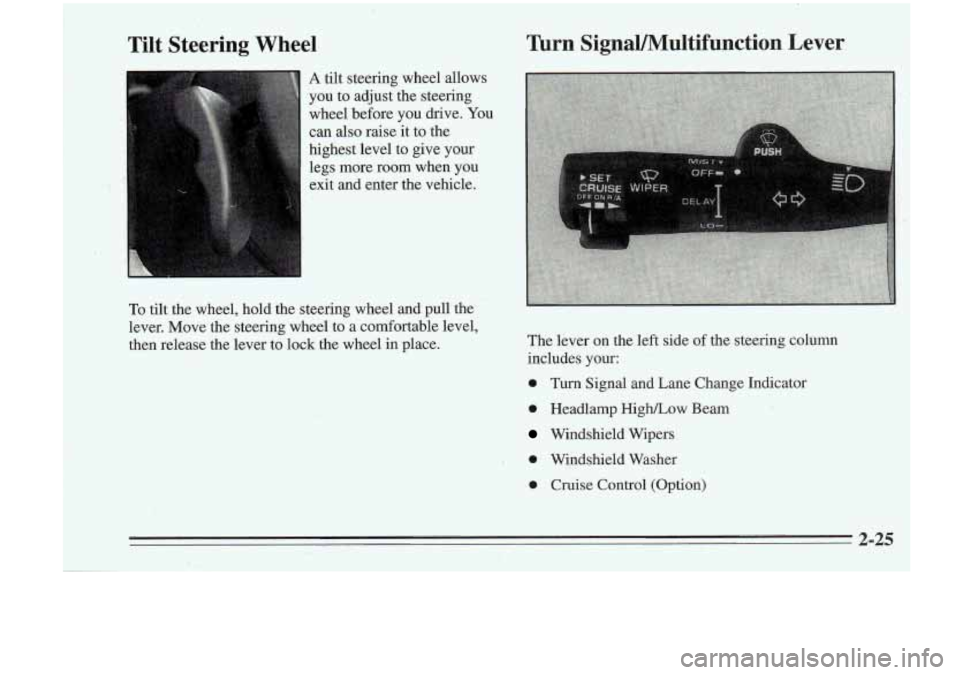
c
Tilt Steering Wheel
A tilt steering wheel allows
you to adjust the steering
wheel before you drive. You
can also raise it to the
highest .level to give your
legs more room when you
e& and enter the vehicle.
To tilt the wheel, hold the steering wheel and pull, the
lever. Move the steering wheel to
a comfortable level,
then release the lever to lock the wheel in place.
Turn SignaVMultifunction Lever
The lever on the left side of the steering column
includes your:
"
0 Turn Signal and Lane Change Indicator
0 Headlamp HighLLow Beam
Windshield Wipers
0 Windshield Washer
0 Cruise Control (Option)
2-25
Page 137 of 340
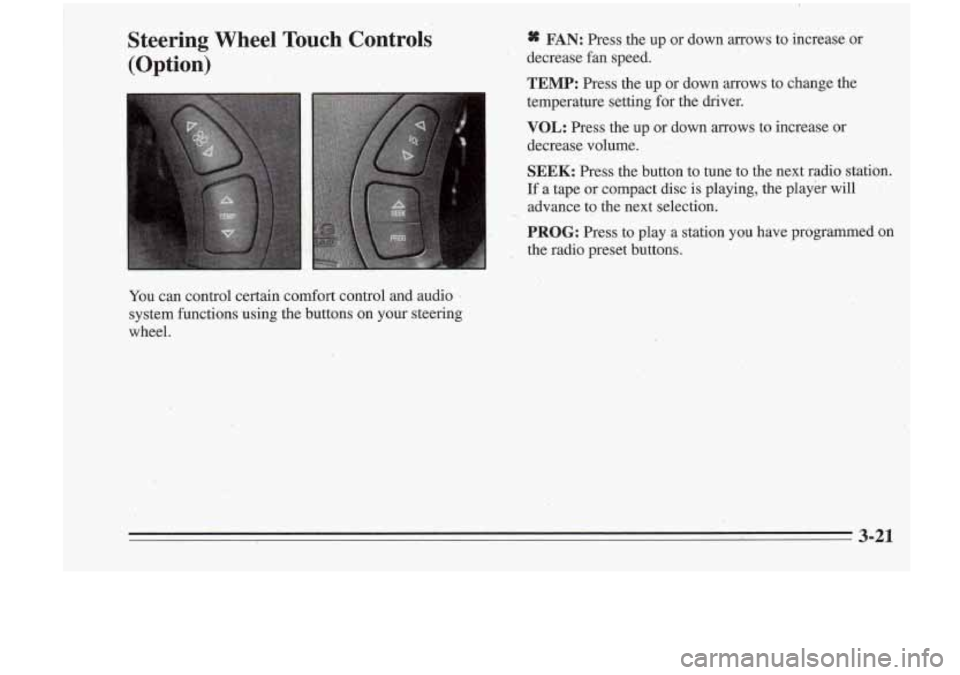
Steering Wheel Touch Controls (Option) 8S FAN: Press the up or down arrows to increase or
decrease fan speed.
TEMP: Press the up or down arrows to change the
temperature setting for the driver.
VOL: Press the up or down arrows to increase or
decrease volume.
SEEK: Press the button to tune to the next radio station.
If a tape or compact disc is playing, the player will
advance to the next selection.
’ PROG: Press to play a station you have programmed on
the radio preset buttons.
You
can control certain comfort control and audio -
system functions using the buttons on your steering
wheel.
3-21
Page 145 of 340
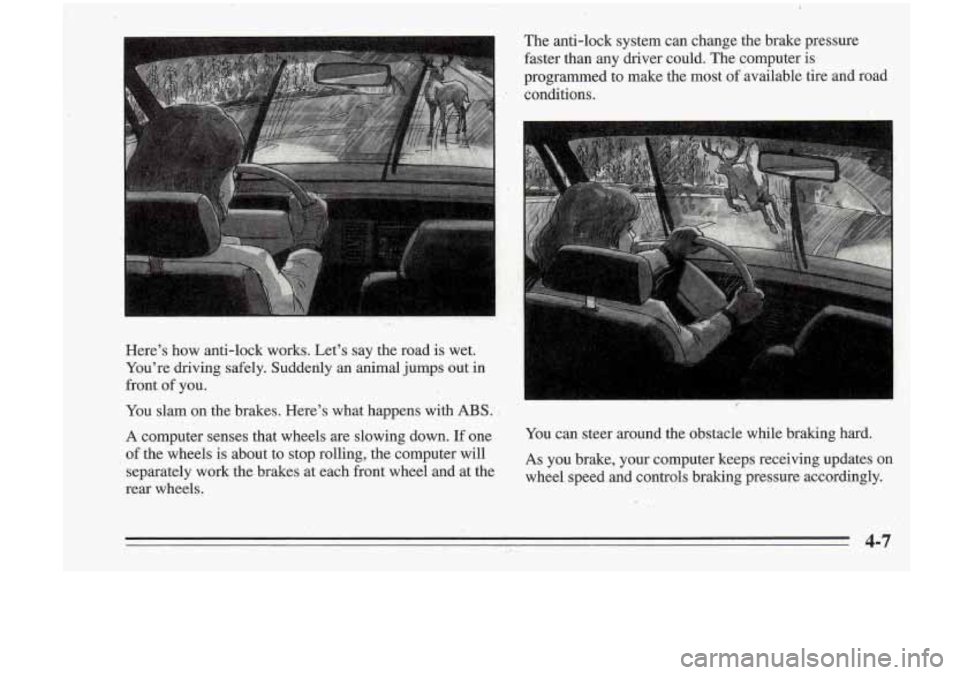
Here's how anti-lock works. Let's say the road is wet.
You're driving safely. Suddenly
an animal juqps out in
front of you. '
You slam on the brakes. Here's what happens with ABS:
A computer senses that wheels are slowing down. If one
of the wheels is about to stop rolling, the computer will
separately work the brakes at each front wheel and at the
rear wheels. The
anti-lock system can change the brake pressure
faster than any
driver could. The computer is
programmed to make the most
of available tire and.road
conditions.
You' can steer around the obstacle while braking hard.
As you brake, your computer keeps receiving updates on
wheel speed and controls braking pressure accordingly.
Page 146 of 340
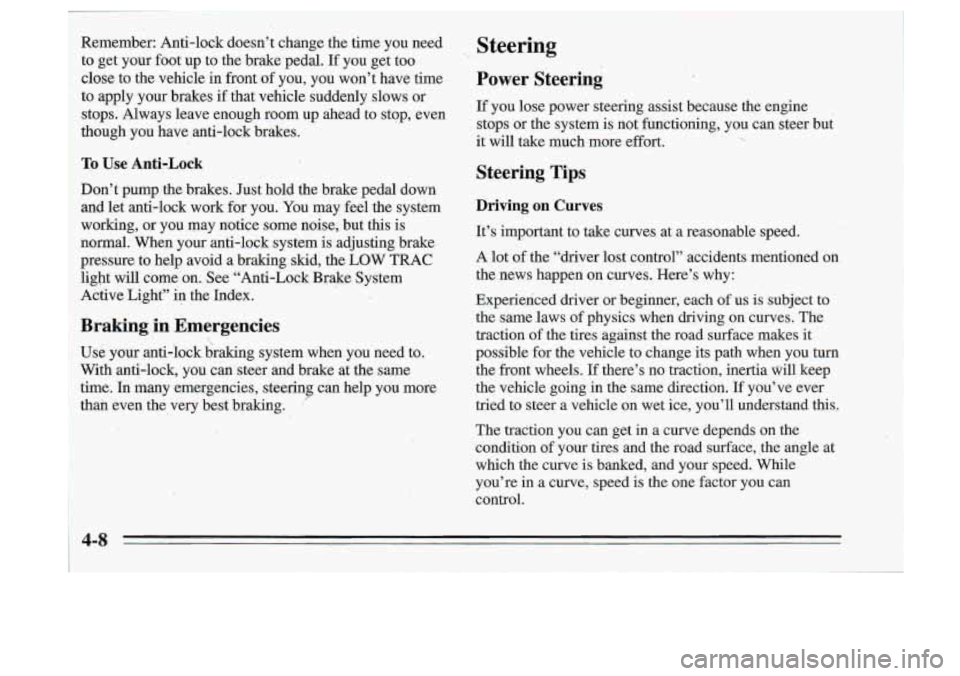
Remember: Anti-iock doesn’t change the time you need
to get your foot up to the brake pedal.
If you get too
close to the .vehicle in front of you, you won’t have time
to apply your brakes
if that vehicle suddenly. slows or
stops. Always leave enough room up ahead to stop, even
though
you have anti-lock brakes.
,_ Steering
Power Steering
If you lose power steering assist because the engine
stops
or the system is not, functioning, you can steer but
it will take much more effort.
. ..
To Use Anti-Lock
Don’t pump the brakes. Just hold the brake pedal down
and let anti-lock work for you. You may feel the system
working, or you may notice some noise, but this is
normal. When your anti-lock system is adjusting brake
pressure to help avoid a braking skid, the LOW TRAC
light will come’on., See “Anti-Lock Brake System
Active Light”
in the Index.
Braking .,in Emergencies
Usti your anti-lock braking system when you’need to.
With anti-lock, you can steer and brake at the same
time.
In many emergencies, steering can help you more
than even the very best braking.
.‘
Steering Tips
Driving on Curves
It’s important to take curves at a reasonable speed.
A lot of the “driver lost control” accidents mentioned on
the news happen on curves. Here’s why:
Experienced driver or beginner, each
of us is subject to
the samelaws of physics when driving on curves. The
traction of the tires against the road surface makes it
possible for the vehicle to change its path when you
turn
the front wheels. If there’s no traction, inertia will keep
the vehicle going in the same direction. If you’ve ever
tried to steer a vehicle on wet ice, you’ll understand this.
The traction you can get in a curve depends on the
condition of your tires and the road surface, $the angle at
which the curve is banked, and your speed. While
you’re in a curve, speed is the one factor you can
control.
Page 150 of 340
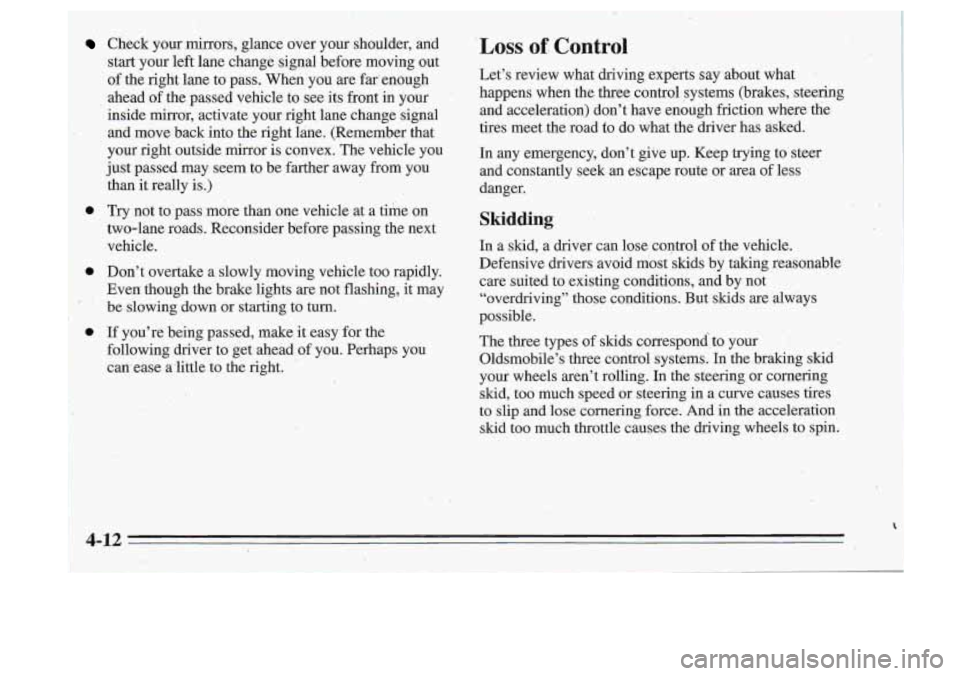
0
0
.. ..
Check your mirrors, glance over your shoklder, and
start your left lane change signal before moving out
of the right lane to pass. When you are far’enough
ahead of the passed vehicle to see its front in your
inside mirror, activate your right$ lane ,change signal
and move back into the right lane. (Remember that
your right outside mirror
is convex. The vehicle you
just passed may seem to be,farther away from
you
than it really is.)
Try not to pass more than one vehicle at a tihe on
two-lane roads. Reconsider before passing the next
vehicle.
Don’t overtake a slowly moving vehicle too rapidly.
Even though the brake lights are not flashing, it.may
be slowing down or starting tu turn.
If you’re being passed, make it easy for the
following driver to get ahead of you. Perhaps you
cmease a,little to the right.
.. : ‘ . .. ~
Loss of Control
Let’s review what driving experts say about what ’
happens when the three control systems (brakes, steering
and acceleration) don’t have enough friction where the
tires meet .the road
to do what ‘the driver has asked.
In any emergency, don’t give up. Keep trying to steer and constantly seek an es-c-gpe route or area
.~f less
danger.
Skidding
In a skid, a driver can lose control of the vehicle.
Defensive drivers avoid most skids by taking reasonable
care suited to existing conditions, and by not
“overdriving” those conditions. But skids are always
possibk.
The three types of skids correspondjo your
Oldsmobile’s three control systems. In the braking skid
your wheels aren’t rolling.
In the steering or cornering
skid, too much speed or steering in
a curve causes tires
to slip and lose cornering force. And in the acceleration
skid too much throttle causes the driving wheels to,spin.
, .*
I
4-12
Page 179 of 340
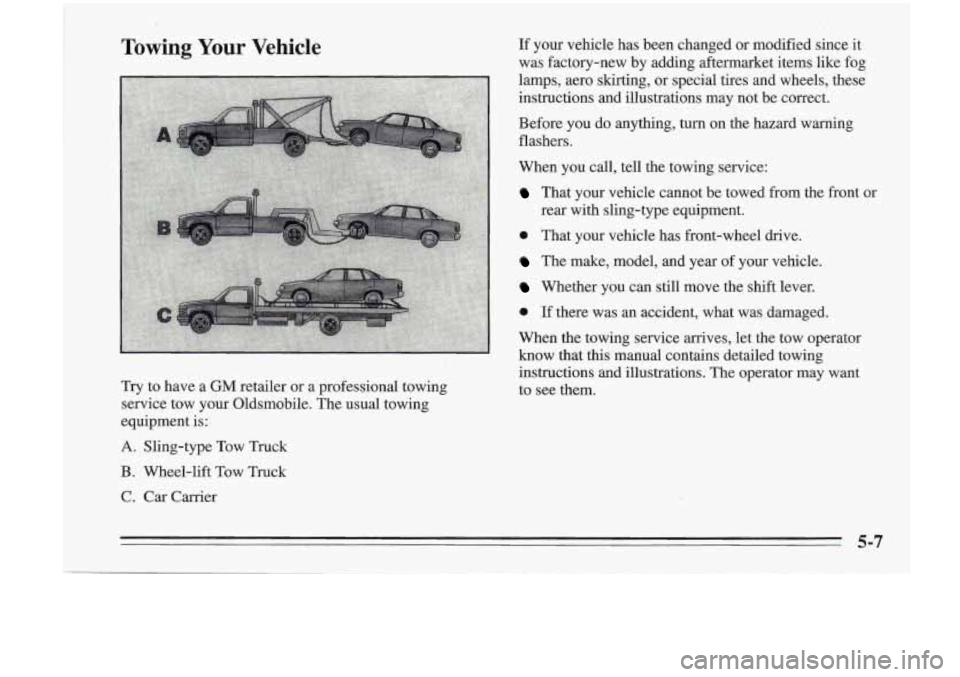
Towing Your Vehicle
Try to have a GM retailer or a professional towing
service tow your Oldsmobile. The usual towing
equipment is:
A. Sling-type Tow Truck
B. Wheel-lift Tow Truck
C.
Car Carrier If
your vehicle has been changed or modified since it
was factory-new by adding aftermarket items like fog
lamps, aero skirting, or special tires and wheels, these
instructions and illustrations may not be correct.
Before
you do anything, turn on the hazard warning
flashers.
When you call, tell
the towing service:
That your vehicle cannot be towed from the front or
rear with sling-type equipment.
0 That your vehicle has front-wheel drive.
The make, model, and year of your vehicle.
Whether you can still move the shift lever.
0 If there was an accident, what was damaged.
When
the towing service arrives, let the tow operator
know that this manual contains detailed towing instructions and illustrations. The operator may want
to see them.
5-7
Page 194 of 340
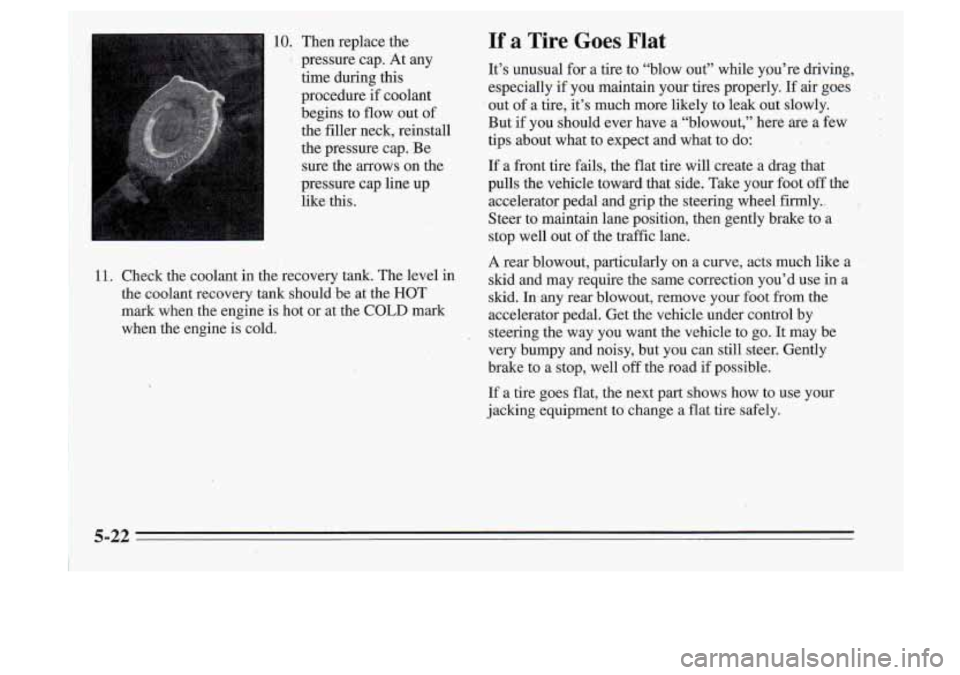
10. Then replace the
’ pressure cap. At any
time during this
procedure if coolant
begins to flow out of
the filler neck, reinstall
the pressure cap. Be
sure the arrows on the
pressure cap line up
like this.
11. Check the coolant in the recovery tank. The level in
the coolant recovery tank should be at the HOT
mark when the engine
is hot or at the COLD mark
when the engine
is cold.
If a Tire Goes Flat
It’s unusual for a tire to “blow out” while you’re \
driving,
especially
if you maintain your tires properly. If air goes
out
of a tire, it’s much more likely to leak out slowly.
But if you should ever have a “blowout,” here are a few
tips about what to expect and what to do:
If a front tire fails, the flat tire will create a drag that
pulls the vehicle toward that side. Take your foot
off the
accelerator pedal and grip the steering wheel firmly.,
Steer to maintain lane position, then gently brake to a
stop well out of the traffic lane.
A rear blowout, particularly on a curve, acts much like a
skid and may require the same correction you’d use in a
skid. In any rear blowout, remove your foot from the
accelerator pedal. Get the vehicle under control by
steering the way you want the vehicle to go.
It may be
very bumpy and noisy, but you can still steer. Gently
brake to a stop, well
off the road if possible.
If a tire goes flat, the next part shows how to
use your
jacking equipment to change a flat tire safely.
Page 337 of 340
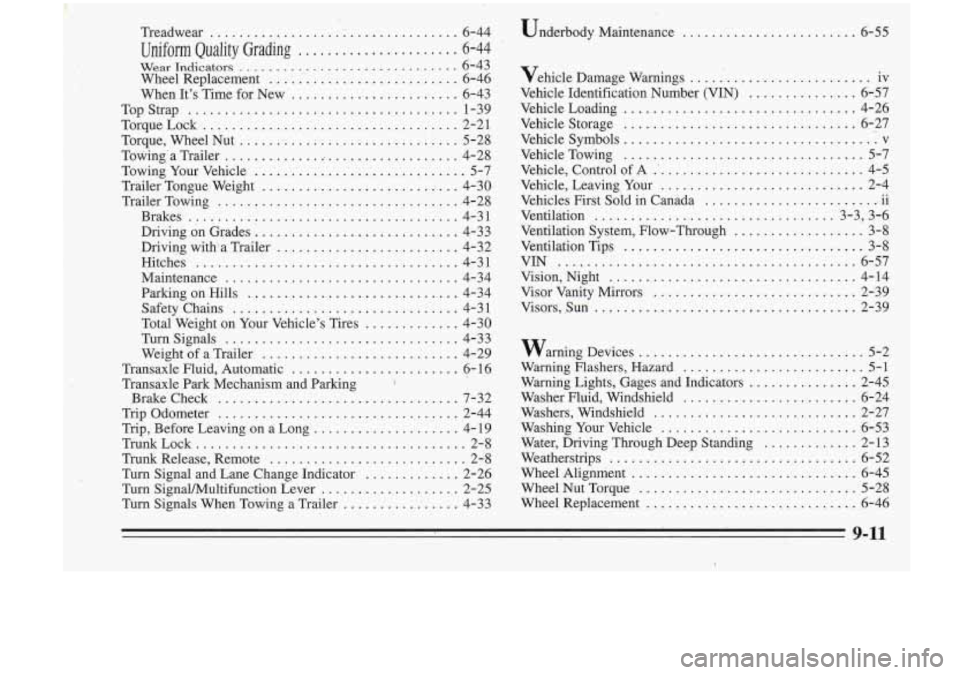
_- t
Treadwear .................................. 6-44
Uniform Quality Grading .................... . 6-44
wear Indicators .............................. 6-43
Wheel Replacement
.... .- ..................... 6-46
When It's Time for New
....................... 6-43
Top.Strap
..................................... 1-39
Torque, Wheel Nut
............................. 5-28
Towing'a Trailer
................................. 4-28
Towing Your Vehicle
.............................. 5-7
Trailer Tongue Weight'
............................ 4-30
Trailer Towing
................................. 4-28
Brakes
..................................... 4-31
Driving on Grades
............................ 4-33
Driving with'a Trailer
......................... 4-3.2
Hitches
.................................... 4-31
Maintenance
................................ 4-34
ParkingonHills
............................. 4-34
Safety Chains
............................... 4-3 1
Total Weight on Your Vehicle's Tires
.............. 4-30
Turn Signals
................................ 4-33
Weight of a Trailer
........................... 4-29
Transaxle Fluid, Automatic
....................... 6- 16
Transaxle Park Mechanism and Parking
I
Brake Check ................................... 7-32
Trip Odometer
................................. 2-44
Trip, Before Leaving on a Long
.................... 4- 19
TrunkLock
..................................... 2-8
Trunk Release, Remote
........................... 2-8
Turn Signal and Lane Change Indicator
............. 2-26
Turn SignaUMultifunction Lever
.................... 2-25
Turn Signals When Towing a Trailer
................ 4-33
TorqueLock
................................... 2-21
......
Underbody
Maintenance ........................ 6-55
Vehicle Damage Warnings
.... .................... iv
Vehicle Identification Number (VIN)
............... 6-57
Vehicle Loading
................................ 4-26
Vehicle Storage
................................ 6-27
Vehicle Symbols
................................... v
Vehicle Towing .................................. 5-7
Vehicle. Control of
A .............................. 4-5
Vehicle. Leaving. Your
............................ 2-4
Vehicles First Sold in Canada
11
Ventilation ................................. 3-3. 3-6
Ventilation System. Flow-Through .................. 3-8
VentilationTips
................................. 3-8
VIN
......................................... 6-57
Vision. Night
.................................. 4-14
Visor Vanity Mirrors
............................ 2-39
Visors. .Sun
..................................... 2-39
.. .........................
warning Devices ............................... 5-2
Warning Flashers. Hazard
......................... 5-1
Warning Lights. Gages and Indicators
............... 2-45
Washer Fluid. Windshield
................... - ....... 6-24
Washers. Windshield
............................ 2-27
Washing Your Vehicle
........................... 6-53
Water. Driving Through Deep Standing
............. 2-13
Weatherstrips
.................. ............... 6-52
Wheel' Alignment
............................... 6-45
WheelNutTorque
.............................. 5-28
Wheel Replacemept
............................. 6-46
9- 11